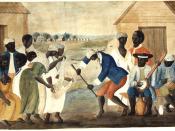Of all the musical styles in the world, the most expressive and captivating is Jazz. Known for its styles, rhythms, scales and structure, it acts as an intermediary between classical music and rock 'n' roll. With its varying instruments, techniques and performers, it strokes the listener with cool, gentle hands, or bats them with hard, swift paws, whirls them away to a world conducted by the soul. The main idea of Jazz is freedom, about working on the guidelines, but also stretching them, exploring new realms of sound, harmony, rhythm and melody. It had to start in somewhere, and that place was America in the late 1800s.
It's late afternoon on Friday in the city of New Orleans. A bustling metropolis of whites and blacks, all heading home after a long days work. Some of the whites had radios in their offices, which they could listen to during the day.
But the coloured slaves working down on the farms sang work songs to pass the day. At nighttime, a segregated city remains segregated, but it doesn't mean that either side misses out on the musical opportunities of enjoyment. While the upper class Caucasians go to a performance by the New Orleans Symphony Orchestra, the African-American and Creole slaves head downtown to Buddy Bolden's Blues Band. One might wonder what was finer: A concert by some of America's finest classically trained musicians playing marches written by John Phillip Sousa, or an uplifting blues and rapid ragtime pieces by possibly the greatest trumpeter of that time? Either way, the listeners definitely enjoyed themselves. And when Sunday rolled around, the upper-class would enter the 'whites-only' churches, and sing plain Gregorian chants that were required to gain entrance to heaven, while the African-Americans, in their run-down, make-shift churches would be singing Gospel...


